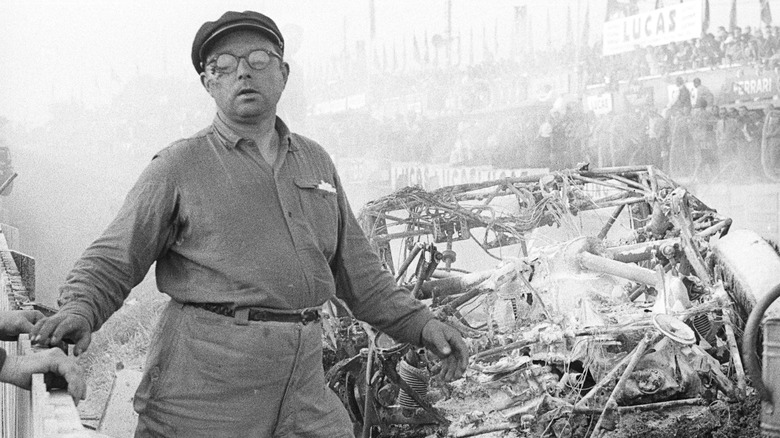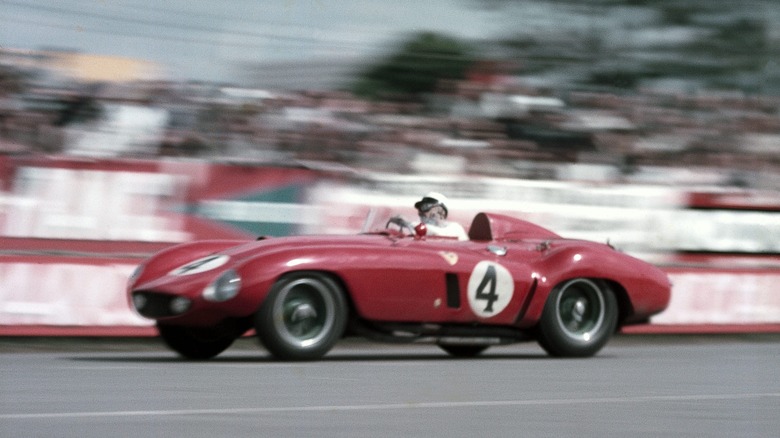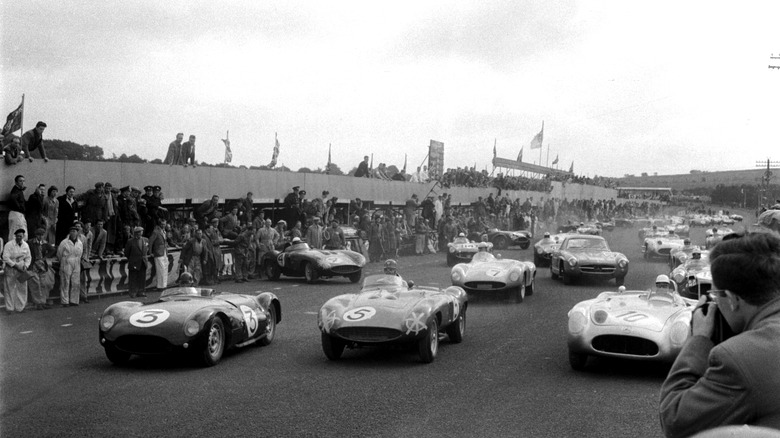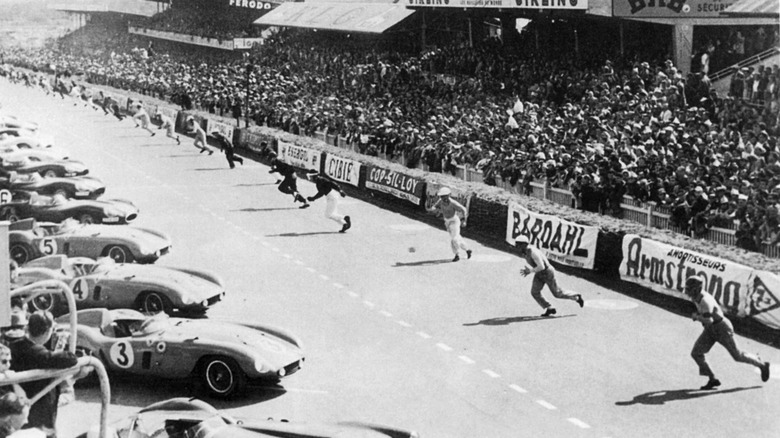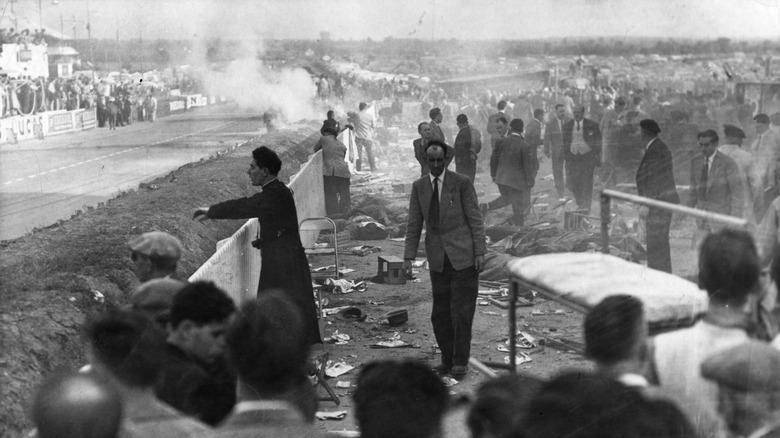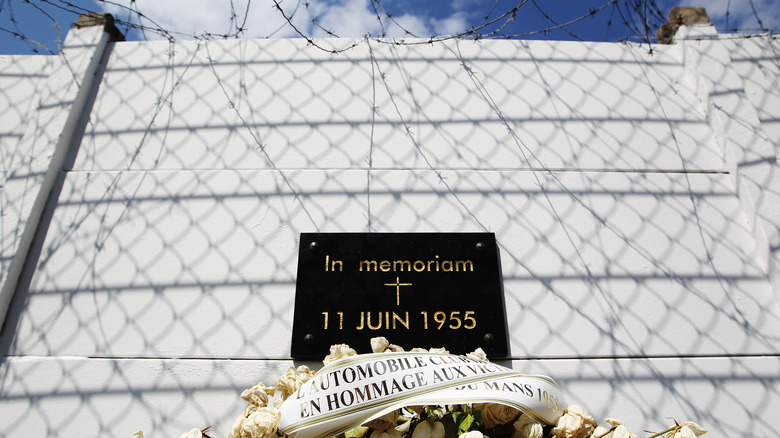The Tragic Story Of The 1955 Le Mans Racing Disaster
There are a few races around the world so iconic that in some ways they overshadow the series they're a part of. NASCAR has the Daytona 500, Formula 1 has the Monaco Grand Prix, while the Indianapolis 500 is such a fixture of the IndyCar schedule that it's worth double points in the championship standings.
In sports car racing, there is no bigger race than the 24 Hours of Le Mans. As the name implies, it's a grueling 24-hour race using a circuit that is around 8.5 miles long, consisting of sections of purpose-built track and closed-off public roads. Winning at Le Mans is one of the most prestigious accomplishments a driver can have on their resume.
That said, racing is a dangerous sport, and Le Mans is no exception. The famed circuit played host to one of the darkest days in the history of motorsports, the 1955 Le Mans disaster, a tragedy that resulted in the death of driver Pierre Levegh as well as dozens of spectators (via GQ).
History of Le Mans
The 24 Hours of Le Mans traces its roots back to Automobile Club de l'Ouest, a French organization that was founded in 1906 and still organizes the race to this day (via Le Mans). The first iteration of the race was held in 1923, on a different circuit than the iconic one used today. The modern circuit is a 13.626 kilometers (8.467 miles) course that combines public roads with sections of purpose-built track.
The circuit features several famous features, like the Dunlop Chicane, the Forrest Esses, and perhaps most well-known, the Mulsanne straight, a long stretch of public roads that allows cars to reach dizzying speeds. Today, the race is part of the FIA World Endurance Championship, a multi-class sports car series that includes both prototype and GT classes racing together.
Many of racing's biggest names have appeared at Le Mans including many Formula 1 and IndyCar drivers. Legendary actor and racecar driver Paul Newman raced at Le Mans, finishing in second place in 1979.
The three favorites going into the 1955 race
The 1955 edition of the 24 Hours of Le Mans likely would've been best remembered for the stellar driver lineup that took part. The field included several Formula 1 champions, including Stirling Moss, Mike Hawthorne, and five-time champion Juan Manuel Fangio.
Heading into the race were three constructors who were expected to battle for victory over the full 24 hours with teams fielding three cars apiece, each driven by two-driver teams taking turns behind the wheel. The first was Ferrari, who were the reigning champions from the previous year and were entering several 121 LMs. Meanwhile, British manufacturer Jaguar had dumped lots of money into developing their challenger, the Jaguar D-Type. According to GQ the third team that had garnered its share of attention ahead of the green flag was Mercedes-Benz, which entered a trio of Mercedes 300 SLRs.
Mercedes had become known as the Silver Arrows, a name they earned after stripping all the paint off their car to drop 1 kilogram and meet a weight requirement back in 1934 (via Mercedes-Benz). The paintless bodies became the team's calling card and in 1955 they were running a fleet of silver cars, this time constructed out of ultra-lightweight magnesium alloy like fellow frontrunning Jaguar D-Type, but different from Ferrari's aluminum body over a steel frame.
The start of the race
The 1955 24 Hours of Le Mans got underway at 4 p.m. local time on June 11, 1955. The race had drawn over 250,000 spectators — with some accounts placing the figure closer to 300,000 — ready to take in the start of the grueling race under warm, clear skies (via GQ). As was typical at the time, the race started with what is known as a Le Mans start. This is when drivers start by standing along the pit wall across from their cars. When given the signal they dash across the pit lane, hop in their cars and speed off. This method was eventually abandoned over safety concerns in later years that driver harnesses weren't being fastened properly (via Car).
This wasn't a concern in 1955, as the prevailing thought was that it was safer for a driver to be thrown clear of the car instead of being strapped into it. Many cars from that era lacked any sort of roll hoop or roll bar, so if a car went upside down and the driver was strapped in, he'd be crushed.
The early stages of the race featured a duel between Fangio in his Mercedes and Hawthorne in his Jaguar, made even more interesting by the fact that Hawthorne was known to have carried a significant dislike of the German manufacturer. Mercedes had produced trucks and aircraft for the Nazis during the war, and Hawthorne, who had lost a family member in World War II, resented that.
The disaster strikes
The darkest moment in the history of motorsports happened several hours into the race, on lap 35. As the frontrunners made their way down the Le Man's Pit Straight, Hawthorne and Fangio were still at the front, per GQ. Hawthorne had just overtaken Austin-Healey driver Lance Macklin when he noticed he was being called in for a pit stop. Hawthorne tried to cut across the track quickly while braking in the process. This caused Macklin — who was now approaching from behind — to steer out of Hawthorne's way. However, in doing so, Macklin steered into the path of French driver Pierre Levegh's Mercedes, which was flying down the Pit Straight at an estimated 150 miles per hour. The two made contact, which sent Levegh's 300 SLR airborne and into an embankment which shredded his car and sent pieces flying into the stands. Newsreel footage shows that Levegh was tossed from the car, the remnants of which were engulfed in flame thanks in part to the flammable magnesium its body was made from, and he lay on the track, dead.
Meanwhile, the parts of the car that entered the stand included the Mercedes' heavy engine, which crushed anyone in its path. Additionally, the car's hood was sent flying and its sharp edges decapitated several spectators. Reports vary, but spectators numbering anywhere from 77 (via The Guardian) to 83 (per GQ) were killed, and dozens more were injured.
The aftermath of the disaster
The magnitude of what happened at the 1955 24 Hours of Le Mans was unlike anything the racing had seen before or, thankfully, since. Mercedes withdrew from the race — their two remaining cars were running first and third when they retired — but this was only several hours after the accident at around 1:45 in the morning. They had approached Jaguar about doing the same, but the British manufacturer declined and went on to win the race, which was completed in full. Hawthorne and co-driver Ivor Bueb took the top step of the podium, but what happened that day greatly affected the British driver.
According to Autoweek, Mercedes did win the Formula 1 and World Sports Car Championships (which Le Mans was part of ) in 1955, but at the end of the year withdrew from racing and went into a decades-long absence from motorsports, directly tied to the traumatic accident at Le Mans. The company made small steps toward returning to the competition when it became an engine manufacturer in the 1980s, and in the years that followed it once again started fielding factory teams in both Formula 1 and sports car racing.
The disaster also damaged motorsports' reputation worldwide. Though an accident as bad as this was and is unfathomably rare, newsreel cameras captured the incident which allowed people all around the world to see the horror for themselves. According to GQ, some countries chose to ban racing, including Switzerland, whose ban is still in place to this day.
